Golden Buddhas and glistening temples grace the landscapes of Thailand, creating a breathtaking backdrop for savoring Bangkok’s vibrant noodle stalls and exploring the country’s opulent coastal escapes.
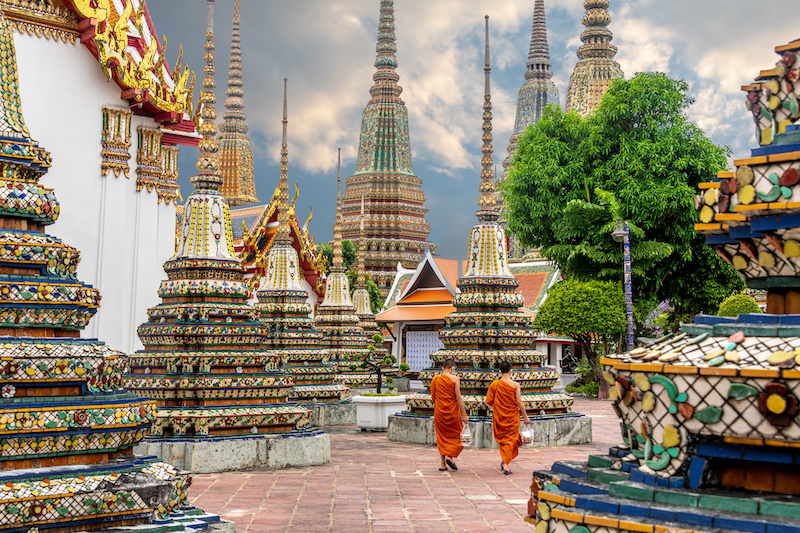
Among Bangkok’s iconic landmarks, Wat Pho stands out as a personal favorite and an enduring symbol of Thai spirituality and culture. This historic temple complex is home to the largest reclining Buddha in the city, the largest collection of Buddha images in Thailand, and the nation’s first public center for education—all within its expansive, eight-hectare grounds.
The highlight of Wat Pho is undoubtedly the majestic Reclining Buddha, stretching 46 meters long and 15 meters high, nestled in a western pavilion. Adorned with intricate mother-of-pearl inlays on its feet depicting the 108 auspicious symbols of Buddha, this figure represents Buddha’s transition into Nirvana. Behind it, 108 bronze bowls await offerings—visitors drop coins for luck and to symbolically give alms.
Despite being one of Bangkok’s premier attractions, Wat Pho typically hosts fewer crowds than its neighbor Wat Phra Kaew, offering a more peaceful experience.
Wat Pho, officially named Wat Phra Chetuphon Wimon Mangkhalaram Rajwaramahawihan, traces its roots to the 16th century Ayutthaya period. It was restored in 1788 under King Rama I and expanded significantly by King Rama III in the 19th century. This expansion included the construction of the Reclining Buddha in 1848 and the addition of 1,431 stone inscriptions—later recognized by UNESCO—for preserving Thai knowledge in medicine, massage, literature, and Buddhism.
Rama III also designated the temple as Thailand’s first public university, using sculptures, inscriptions, and murals as open learning tools.
Wat Pho is not just a spiritual sanctuary—it’s also the birthplace of traditional Thai massage. Rama III’s mandate preserved this healing tradition at a time when it was fading. Today, the Wat Pho Thai Traditional Massage School operates massage pavilions within the temple grounds and classrooms nearby.
Visitors can book Thai or foot massages (30–60 mins) or even enroll in one-day or multi-day training courses in Thai massage. Courses begin at 12,000B and are held daily, except Sundays.
Opening Hours: Daily, 8:30am–6:30pm
Entry Fee: 200B (includes a free bottle of water)
Dress Code: Modest attire required (long pants/skirts and sleeved shirts); shoes must be removed inside temples.
Phra Ubosot: The temple’s main ordination hall features stunning murals and houses the revered Phra Buddha Deva Patimakorn on a golden pedestal containing the ashes of King Rama I.
Buddha Galleries: Wat Pho boasts over 1,000 Buddha statues, including 394 gilded images along cloister galleries and rare Sukhothai-era figures like Phra Chinnarat and Phra Chinnasri.
Royal Chedi: Four elaborately tiled stupas honor the first four Chakri kings, while 91 smaller chedi contain royal relics and ashes.
Ancient Inscriptions: Near Phra Ubosot, you’ll find stone inscriptions and bas-reliefs from the Ramakian, Thailand’s version of the Ramayana.
Phra Mondop: A sacred scripture library guarded by mythical yaksha figures and steeped in local legend.
Sala Kan Parian: An Ayutthaya-era hall that once served as the temple’s central worship space.
Granite Guardians: Watch for statues of Chinese warriors, farmers, and even Marco Polo, brought to Thailand as ballast and later repurposed as temple guardians.
Bodhi Tree & Rock Gardens: Relax near a descendant of the original Bodhi tree or wander through tranquil rock gardens dotted with statues of healing hermits.
Pa Aew: A humble stall offering authentic Bangkok-style curries and stir-fries.
Tonkin Annam: A Vietnamese gem known for pho, banana blossom salad, and Hue-style specialties like bánh bèo.
Chakrabongse Villas: A luxurious riverside hideaway in a historic royal palace compound.
Arun Residence: A charming multilevel wooden house directly across from Wat Arun, with stylish rooms and panoramic views.
Arrive early to beat the crowds and heat.
Don’t rush—explore the full grounds, not just the Reclining Buddha.
Respect temple etiquette and dress modestly.

Phra Borom Maharatchawang – A Royal Legacy Since 1782
The Grand Palace is one of Bangkok’s most iconic and sacred landmarks. Originally a royal residence, this 94.5-hectare complex now hosts state ceremonies and draws millions of visitors each year, thanks to its rich history, dazzling architecture, and spiritual importance.
Chakri Mahaprasat Hall
A grand blend of Italian Renaissance and traditional Thai architecture topped with Thai-style spires (mon·dòp). The central spire holds the ashes of Chakri kings.
Wat Phra Kaew (Temple of the Emerald Buddha)
The spiritual heart of Thailand, housing the revered Emerald Buddha statue.
Dusit Hall
A royal audience chamber turned funerary hall in Ratanakosin style.
Borombhiman Hall
A French-inspired palace once home to Rama VI—visible from outside only.
Amarindra Hall
The official coronation hall, still used for royal ceremonies.
Inner Palace (not open to public)
Once home to royal harems guarded by trained female sentries.
Daily: 8.30 AM – 3.30 PM
Entry via the third gate from the river pier.
500 Baht (includes Wat Phra Kaew & Queen Sirikit Museum)
Free for Thai citizens
Guides available at the entrance | Audio guides: 200 Baht
Advance booking: Royal Grand Palace official site
Strictly modest attire required:
No sleeveless tops, short pants, or see-through clothes
Skirts/trousers must be long
Sarongs provided at the gate if needed
Shoes allowed, but must be removed inside temples
Wheelchair-friendly grounds
Accessible toilets available
Visit early morning to beat the heat and crowds
Beware of scams: Ignore anyone saying the Palace is closed
Carry water, as on-site refreshments may be limited
Ming Lee: Classic Thai flavors right near the entrance
Navy Club: Scenic riverside seafood with a local touch
Err: Thai cocktails and spicy tapas in a hip setting
Asadang: Vintage vibes in a Chinatown shophouse
Feung Nakorn Balcony: Spacious rooms around a peaceful garden
Arom D: Chic design and rooftop views in Tien Village

Rising dramatically from the banks of the Chao Phraya River, Wat Arun—also known as the Temple of Dawn—is one of Bangkok’s most recognizable landmarks. Named after the Indian god of dawn, Arun, this temple holds deep historical and cultural significance, dating back to the 16th century.
The centerpiece of Wat Arun is its 82-meter-high Khmer-style prang (tower), built in the early 19th century under Kings Rama II and Rama III. It is decorated with detailed floral mosaics crafted from broken Chinese porcelain, and visitors can climb its steep steps for panoramic views of the river and surrounding cityscape.
The temple’s main ordination hall features a Buddha image believed to have been designed by Rama II. The surrounding murals are from the reign of Rama V and vividly depict scenes from the life of Prince Siddhartha, including his realization of suffering in the world—an event that led to his spiritual awakening.
Beyond the main spire and ordination hall, the temple complex includes two viharns (sanctuaries), a hor trai (scripture library), and six open-air sala pavilions along the riverfront. These structures reflect traditional Thai architecture and are now frequently used as docks for tourist boats.
16th Century: Originally known as Wat Makok, a modest riverside temple
1767: King Taksin, escaping Burmese forces, arrives at sunrise and interprets the site as auspicious, renaming it Wat Chaeng
Late 18th – 19th Century: Renamed Wat Arun under Rama II, who began enlarging the central prang; completed by Rama III in 1842
Modern Day: Underwent major restoration in 2017 to preserve its ornate details
Opening hours: Daily from 8:00 AM to 6:00 PM
Entry fee: 50 Baht
Location: Just across the river from Wat Pho; accessible via the Chao Phraya Express Boat or the cross-river ferry from Tien Pier (operating 5:00 AM – 9:00 PM)
As Wat Arun is an active Buddhist temple, visitors must wear modest, culturally respectful clothing.
Long pants or skirts and tops that cover the shoulders are required
Sheer or see-through clothing is not permitted
Sarongs are available for rent at the entrance (20 Baht with a 100 Baht refundable deposit)
Shoes must be removed before entering certain areas of the temple
Late Afternoon: Ideal for lighting, as the western sun illuminates the temple beautifully
Sunset Views: Best seen from across the river along Th Maha Rat, although some locals may request a 20 Baht viewing fee
Evening: Around 7:00 PM, the temple is lit up, offering stunning photo opportunities with the evening sky
Tonkin Annam: A popular Vietnamese restaurant located just across the river
The Rooftop and Amorosa Bars: Rooftop venues offering direct views of Wat Arun, perfect during sunset
Arun Residence: A charming riverside guesthouse with seven stylish rooms, a rooftop bar, and a cozy library
Sala Ratanakosin: A sleek, modern hotel with open-plan rooms and expansive river views, designed for comfort and style
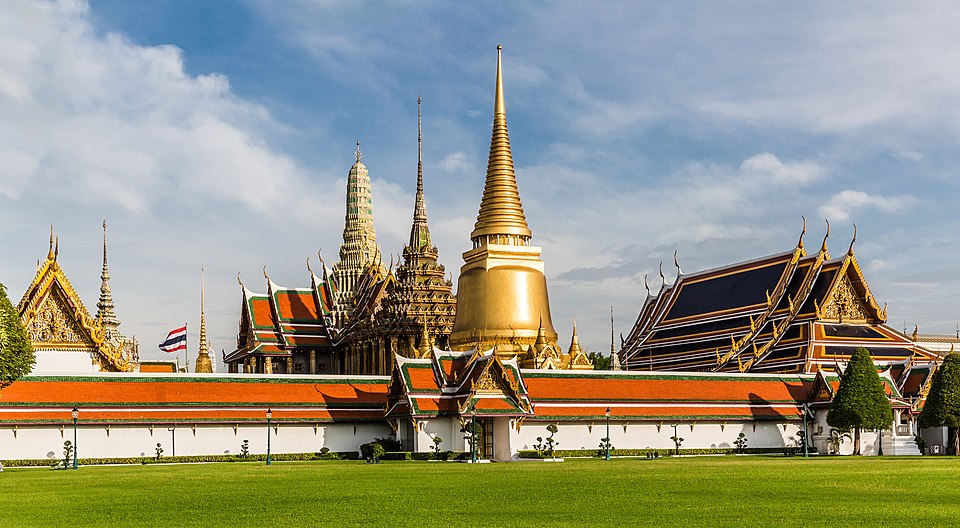
Architecturally magnificent and spiritually profound, Wat Phra Kaew (Temple of the Emerald Buddha) stands as the most sacred site in Thailand. Within its walls resides the revered Emerald Buddha, symbolizing the union of Buddhism and the Thai monarchy. Adjacent to the temple is the Grand Palace, once the royal residence and a city within a city, layered in tradition, ritual, and social hierarchy.
Consecrated in 1782, the first year of Bangkok’s reign, this complex remains Bangkok’s most visited attraction and a vital pilgrimage site for devout Buddhists.
Upon entering the temple grounds, you’ll encounter yaksha—mythical guardian giants from the Thai epic Ramakian—flanking the gate. Beyond them lies the bòht (ordination hall), where the 66 cm-tall Emerald Buddha sits atop a towering, gilded pedestal.
While the statue itself is small, the elaborate shrine and surrounding ornamentation often steal the attention of first-time visitors. The statue’s origins are mysterious, first recorded in 15th-century Chiang Rai, but believed to be stylistically linked to the 13th–14th century.
The Emerald Buddha is draped in seasonal royal robes—for hot, rainy, and cool seasons—ceremonially changed by the King himself at the start of each season.
Surrounding the complex is a 2 km cloister lined with 178 murals narrating the Ramakian, the Thai adaptation of the Ramayana.
Key characters include:
Rama: the green-faced hero
Sita: his loyal bride
Ravana: the many-faced demon king
Hanuman: the white monkey warrior and loyal ally
This epic tale unfolds in vibrant scenes of war, magic, loyalty, and triumph. Despite the bustle of the main grounds, the cloister offers a quieter, shaded retreat to enjoy the artwork.
Commissioned by Rama I, Phra Mondop is a spectacular library built to store sacred Buddhist scriptures. Highlights include:
A seven-tiered roof
A floor woven with strands of silver
Intricately carved mother-of-pearl doors
Though the interior is not open to the public, the structure stands out as one of the most beautiful and ornate buildings in the temple grounds.
Nearby are:
Prasat Phra Thep Bidon: a Khmer-style royal pantheon
Phra Si Ratana Chedi: a stunning golden stupa
1782: King Rama I founded Wat Phra Kaew and began construction of the Grand Palace
1784: The Emerald Buddha was installed after being brought from Vientiane
The Phra Ubosot (ordination hall) reflects Ayutthaya-style architecture and features multi-tiered roofs and sacred boundary stones
Opening Hours: Daily, 8:30 AM – 3:30 PM
Admission: Free for Thai nationals; 500 Baht for foreigners (includes both Wat Phra Kaew and the Grand Palace)
Entrance: Via the third gate from Tha Chang Pier, clearly marked along Th Na Phra Lan in Phra Nakhon District
This is one of Thailand’s most sacred sites, and strict dress codes are enforced:
No shorts, mini-skirts, sleeveless shirts, spaghetti straps, or cropped pants
Clothing must cover shoulders, arms, and legs
Sarongs can be borrowed at the entrance if needed, but expect queues and delays if you are not dressed appropriately
Tickets are sold inside the complex—ignore anyone outside claiming it’s closed
Hydration is important; carry water as the courtyards can get very hot and shaded rest areas are limited
Early morning visits are ideal to avoid crowds and midday heat
The mural gallery often remains quiet even when the main temple areas are crowded—take your time there
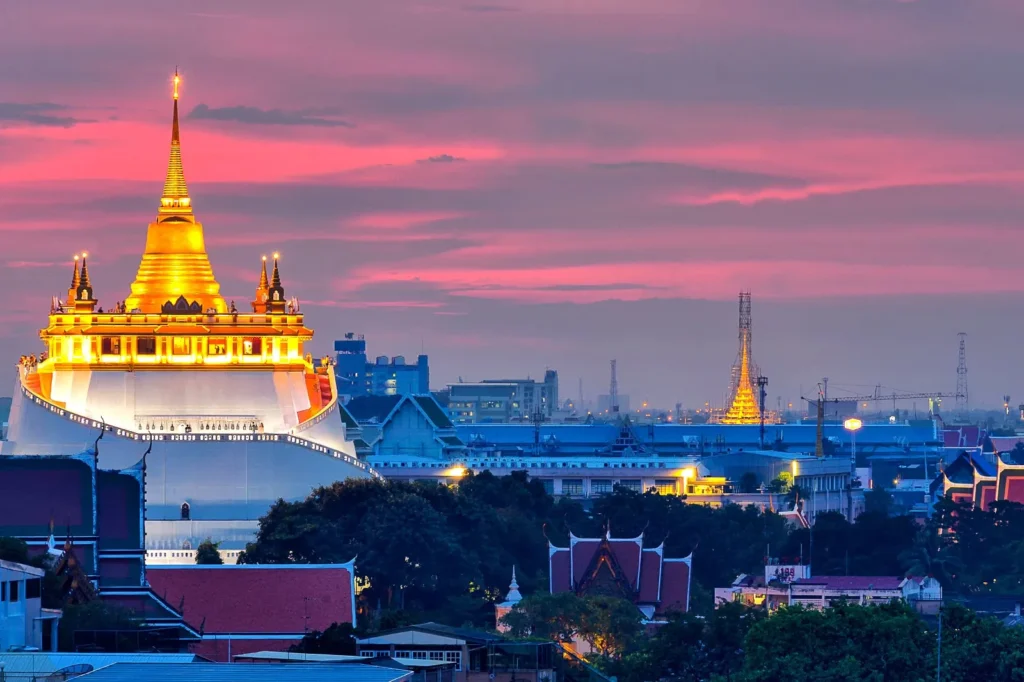
One of Thailand’s most iconic landmarks, Wat Phra Kaew houses the Emerald Buddha, the most revered image in Thai Buddhism. This sacred site is attached to the Grand Palace, the former royal residence, which was established in 1782, the founding year of Bangkok.
Emerald Buddha: A 66cm tall jade statue placed high on a gilded altar and ceremoniously dressed in seasonal royal robes. Though small, it holds immense spiritual significance.
Ramakian Murals: A 2km-long series of 178 murals depicting the Thai version of the Ramayana epic, beginning at the north gate and running clockwise.
Phra Mondop: A sacred library with a silver floor, seven-tiered roof, and detailed mother-of-pearl inlay (not open to the public).
Phra Ubosot: The main chapel built in Ayudhaya-period style, commissioned by King Rama I.
Location: Entrance via the third gate from Tha Chang Pier, Th Na Phra Lan, Phra Nakhon District
Opening Hours: Daily from 8:30 am to 3:30 pm
Entry Fee: Free for Thai nationals; 500 THB for foreigners (includes Grand Palace access)
Dress Code: Strictly enforced. No shorts, sleeveless tops, or revealing clothing. Visitors who are not appropriately dressed may be required to wear a sarong.
Tip: Ignore anyone outside claiming the temple is closed. They are likely to be touts or scammers.
The Golden Mount (Phu Khao Thong) offers a peaceful yet energizing climb that rewards visitors with sweeping views of Bangkok. The hilltop stupa was initially commissioned by King Rama III and later completed by King Rama V, who enshrined a Buddha relic gifted by the British.
The tree-lined path to the summit is lined with memorials and religious symbols, making the journey as meaningful as the view itself. Adjacent to the Golden Mount is Wat Saket, home to striking murals, including graphic depictions of Buddhist hell behind the main Buddha statue.
Location: Phu Khao Thong, off Th Boriphat
Opening Hours: Daily from 7:30 am to 5:30 pm
Entry Fee: 50 THB for foreigners; free for Thai nationals
Dress Code: No strict dress requirements, but respectful, modest clothing is encouraged
Tip: During November, the temple hosts a fair featuring a candlelight procession up the Golden Mount — a highlight for those visiting during this time.
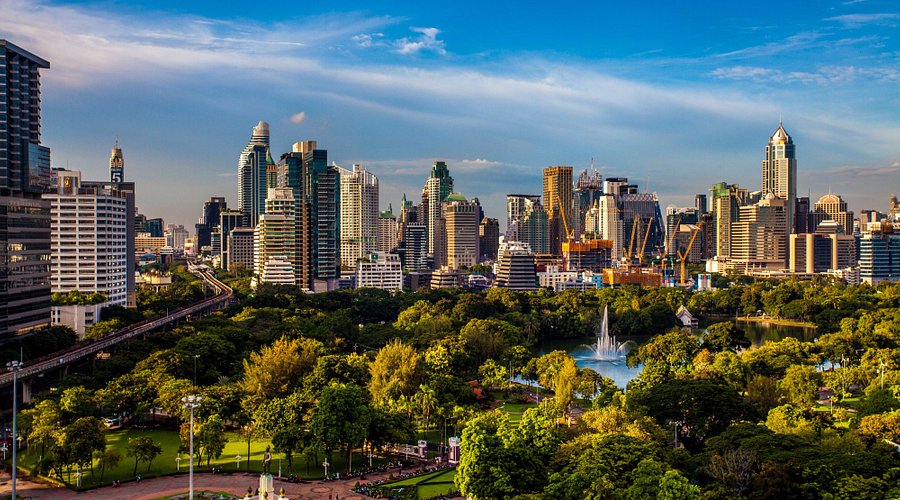
Named after the Buddha’s birthplace in Nepal, Lumphini Park is central Bangkok’s largest and most beloved green space. Spanning 58 hectares, the park features an artificial lake, shaded walking paths, grassy lawns, and occasional encounters with the park’s famously large monitor lizards. It’s a refreshing escape from the urban intensity, right in the heart of the city.
Originally a royal reserve, Lumphini was transformed into a public park in 1925 by King Rama VI (Vajiravudh), whose statue now watches over the southwestern entrance.
Morning Atmosphere: At dawn, the park comes alive with Thai-Chinese residents practising t’ai chi, group aerobics, and slow-paced jogging adapted to the humid climate.
Recreation: Paddleboats are available on the lake, there are several playgrounds for children, and informal outdoor gyms offer a distinctly local fitness experience.
Clock Tower: The Chinese-style clock tower in the southeastern corner, designed by Italian architect Mario Tamagno for the 1925 Siamrath Phipitthapan Trade Fair, is a unique architectural feature ideal for photography.
Cold drinks can be purchased near park entrances.
In the northwest corner, street-food vendors set up from around 5 pm, offering a casual dining option after sunset.
Note: The park’s borders, particularly at night, may attract sex workers and related activity, so some areas are best avoided after dark.
Location: Bounded by Th Sarasin, Rama IV Rd, Th Witthayu (Wireless Rd), and Th Ratchadamri
Opening Hours: Daily from 4:30 am to 9:00 pm
Entry Fee: Free
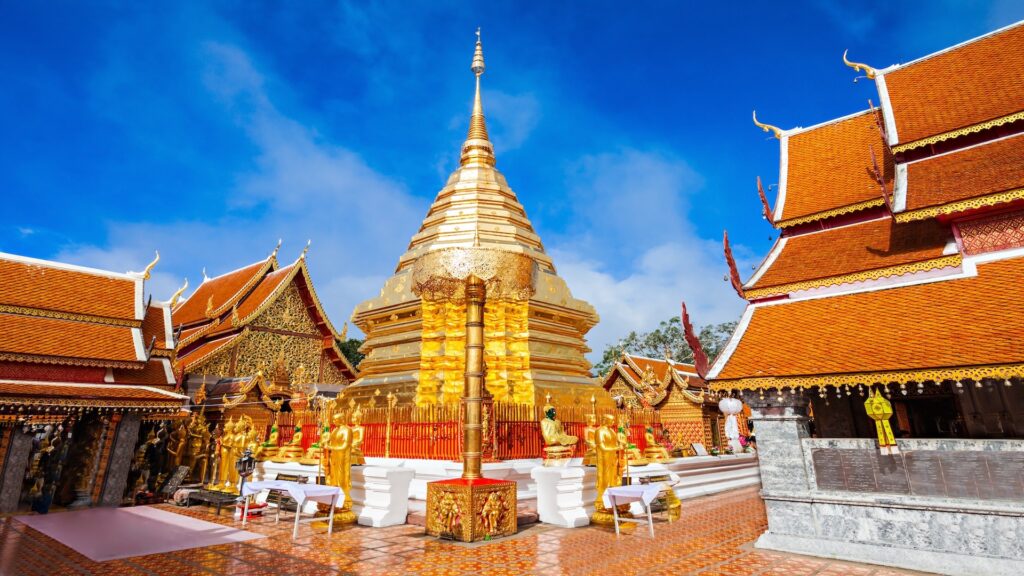
Perched high on a mountain overlooking Chiang Mai, Wat Phra That Doi Suthep is one of northern Thailand’s most revered temples. Its significance is intertwined with local legend, and it holds an important place in the spiritual and cultural life of the region.
The temple was founded in 1383 by King Keu Naone to house a relic believed to be a fragment of the Buddha’s shoulder bone. The relic was brought to the Lanna Kingdom by a wandering monk from Sukhothai. The story goes that the relic broke into two pieces when it arrived at the base of Doi Suthep Mountain. One fragment was enshrined at Wat Suan Dok, while the second was mounted onto a white elephant, which wandered the jungle before dying on the mountain—indicating the exact spot for the temple’s construction.
The temple is an outstanding example of northern Thai architecture and can be accessed by a 306-step staircase, flanked by naga (mythical sea serpents). The climb is symbolic, allowing devotees to accrue merit on their way up. At the top of the stairs, the terrace is dotted with breadfruit trees, small shrines, rock gardens, and monuments, including a statue of the white elephant that carried the Buddha relic to its final resting place.
Before entering the inner courtyard, visitors pay their respects to Mom, a guardian dragon statue. The inner terrace features a gleaming golden chedi that enshrines the relic, surrounded by smaller shrines and Buddha statues in a variety of poses and materials. The temple’s crowning five-tiered umbrella marks Chiang Mai’s independence from Burma and its union with Thailand.
Visitors can walk around the chedi, leaving lotus blossoms and other offerings, which are part of the ongoing pilgrimages to the temple. Within the compound, the Doi Suthep Vipassana Meditation Center offers religious outreach programs for those looking to deepen their spiritual practice.
Getting There:
Rót Daang (red trucks) run from several points in Chiang Mai, such as in front of the zoo (40B per person) or Wat Phra Singh (50B per person). However, these only depart once full, and prices can vary.
Alternatively, private rides can be arranged via taxi or Grab Car.
Many visitors opt to cycle up on mountain-bike tours from Chiang Mai, or they may walk from the Chiang Mai University.
The climb to Wat Phra That Doi Suthep is a serene experience, and arriving early or late in the day offers a peaceful visit, away from the crowds.
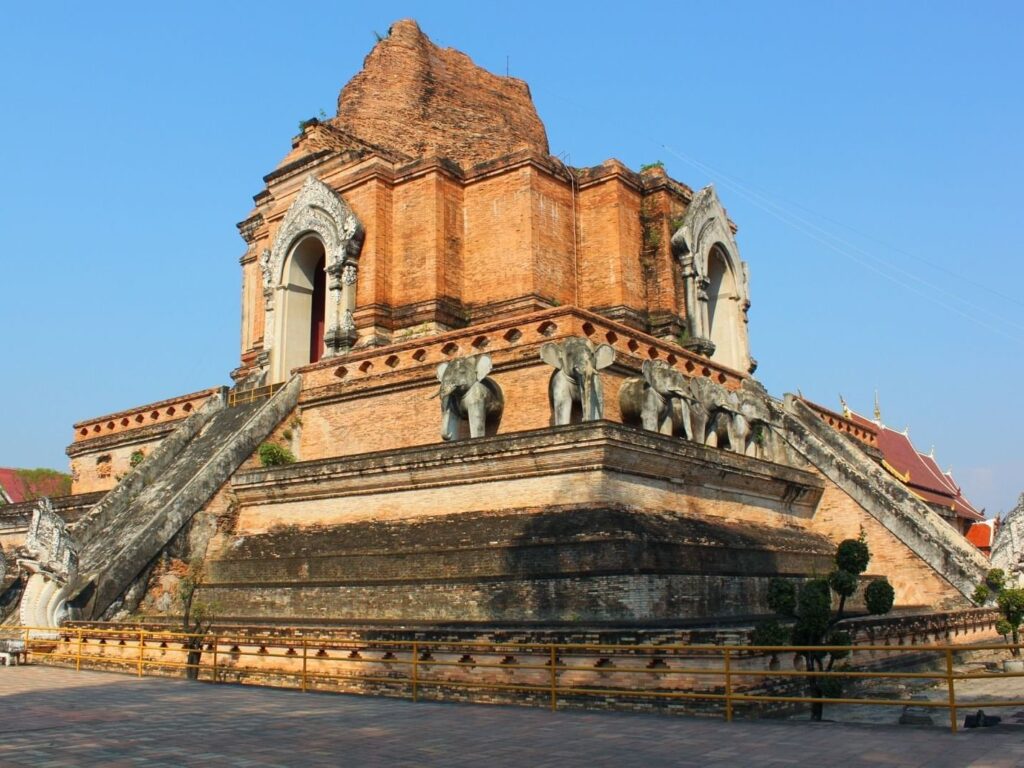
Though not as grand as Wat Phra Singh, Wat Chedi Luang impresses visitors with its towering, ruined Lanna-style chedi. Built in 1441, this chedi was once the tallest structure in ancient Chiang Mai, and the sprawling compound around the stupa exudes a powerful, atmospheric aura.
The Phra Kaew (Emerald Buddha), now enshrined in Wat Phra Kaew in Bangkok, was housed in the eastern niche of the chedi until 1475. Today, visitors can view a jade replica of this sacred Buddha statue.
The chedi’s original top was lost, possibly due to a 16th-century earthquake or during the 1775 Burmese recapture of Chiang Mai. The exact cause of the damage remains uncertain. Like many other ancient monuments in Chiang Mai, Wat Chedi Luang fell into ruin until a restoration project in the 1990s by UNESCO and the Japanese government helped stabilize the structure and prevent further deterioration.
As you explore the chedi, the restoration work on the four naga stairways, facing each of the cardinal directions, is easily visible. The base of the chedi features five elephant sculptures on its southern face: four are reproductions, while the elephant on the far right is the original brick and stucco piece. Interestingly, the restoration team stopped short of reconstructing the spire, as there was no consensus on its original appearance.
Inside the main wí·hăhn (sanctuary) stands the revered Phra Chao Attarot statue, a standing Buddha flanked by two disciples. Further chapels and statues, including a reclining Buddha and a seated Buddha with Chinese influences, are found in teak pavilions at the rear of the compound. The daily Monk Chat under a tree on the grounds attracts a crowd of interested travelers, offering an opportunity to engage with local monks and learn about Buddhism.
As you enter the compound via the main entrance on Th Phra Pokklao, you’ll pass Làk Meuang, another prominent feature of Wat Chedi Luang, adding to the site’s historic and cultural significance.
WhatsApp us